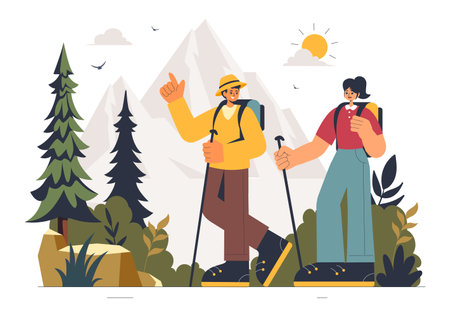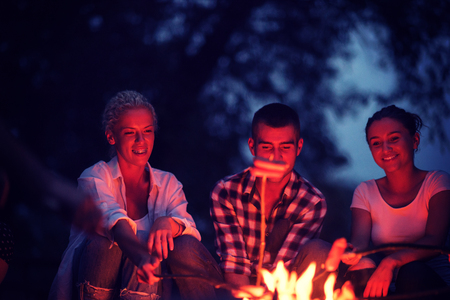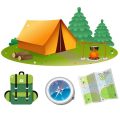1. Choosing the Perfect Campsite
When planning a group camping trip with friends and family, picking the right campsite is one of the most important steps. A great location can make or break your experience. Here are some easy tips to help you choose a campground that works well for a group in the U.S.
Accessibility Matters
Make sure the campground is easy for everyone in your group to reach. If some people are coming from out of town, look for spots near major highways or airports. Also, check if the roads leading to the site are suitable for RVs or trailers if your group plans to bring them.
Amenities That Keep Everyone Comfortable
Different campgrounds offer different levels of comfort. For groups, its helpful to find sites with useful amenities like:
| Amenity | Why It’s Helpful for Groups |
|---|---|
| Restrooms & Showers | Makes it easier for large groups to stay clean and comfortable |
| Picnic Tables & Fire Rings | Simplifies mealtime and group activities around the fire |
| Group Campsites | Larger space designed for multiple tents and shared use |
| Electric Hookups | Useful for RVs or charging devices |
Look for Fun Nearby Activities
You’ll want to keep everyone entertained during your trip. Choose a campground near attractions like:
- Hiking trails
- Lakes or rivers (for swimming, fishing, kayaking)
- Biking paths
- Parks with playgrounds (great if kids are joining)
This way, there’s something fun for every age group and interest level.
Understand Reservation Policies
Campsites in popular areas often fill up fast—especially on weekends and holidays. Here’s what you should know about booking in advance:
| Reservation Type | Description |
|---|---|
| First-Come, First-Served | No reservations; arrive early to claim a spot—risky for big groups |
| Online Reservations | You can book through websites like Recreation.gov or ReserveAmerica.com |
| Email/Phone Reservations | Mainly used by smaller private campgrounds—call ahead to confirm availability |
If youre planning during peak season (like summer), try to book at least 4–6 months ahead when possible.
2. Coordinating the Group
Getting everyone on the same page is one of the most important parts of planning a successful group camping trip. Whether youre heading to a national park or setting up tents at a local campground, good communication and clear organization can make or break your adventure. Here’s how to keep things running smoothly from the start.
Assigning Responsibilities
One person can’t do everything, especially when it comes to group trips. Divide up tasks so everyone has a role and feels involved. Here are some common responsibilities you can assign:
| Task | Who Might Be Best |
|---|---|
| Trip Coordinator | The planner in your group who enjoys organizing details |
| Meal Planner & Cook | The foodie or someone who loves cooking outdoors |
| Gear Checker | The person who owns gear or knows what’s essential |
| Activities Leader | The energetic one who loves hiking, games, and fun ideas |
| Safety/First Aid Lead | Someone with basic first aid knowledge or CPR training |
Setting a Budget Everyone Can Agree On
A clear budget helps avoid awkward conversations later. Talk openly about costs early in the planning process. Consider expenses like campsite fees, food, gas, firewood, and gear rentals. Use a shared spreadsheet (like Google Sheets) to track everything so its transparent for all members.
Sample Budget Breakdown (Per Person)
| Category | Estimated Cost |
|---|---|
| Campsite Fees | $25 |
| Food & Drinks | $30 |
| Transportation/Gas | $20 |
| Smores & Snacks | $10 |
| Total Estimated Cost | $85 per person |
Keeping Communication Clear and Simple
Create a group chat using apps like WhatsApp, Facebook Messenger, or GroupMe to keep everyone in the loop. For larger groups or more complex trips, consider using tools like Google Docs for planning checklists or Trello for task assignments. Set deadlines for decisions—like picking dates or finalizing the meal plan—to help keep things moving.
Tips for Smooth Communication:
- Create polls to decide on dates and locations quickly.
- Keeps updates short and easy to read.
- Avoid spamming the group with unrelated messages.
The more you coordinate ahead of time, the less stress you’ll have once you’re out in nature. Keeping things organized will make your group camping trip not just doable—but awesome.

3. Planning Meals and Campfire Cooking
Feeding a group during a camping trip doesn’t have to be stressful. With a little planning and teamwork, you can create delicious meals that keep everyone happy and full of energy. Here’s how to make meal planning fun, collaborative, and hassle-free for your next group adventure.
Create a Collaborative Meal Plan
Start by organizing a simple meal schedule that outlines who’s responsible for each meal. Involving everyone in the planning not only lightens the load but also adds variety to your menu. Consider dietary restrictions, preferences, and portion sizes based on your group size.
Sample Group Meal Schedule
| Day | Breakfast | Lunch | Dinner |
|---|---|---|---|
| Friday | Sara & Mike – Breakfast Burritos | Group Pack Sandwiches | Amy & John – Chili with Cornbread |
| Saturday | Tina – Pancakes & Bacon | Wrap Bar (DIY) | Carlos – Grilled Burgers & Veggies |
| Sunday | Leftovers or Bagels & Fruit | Packed Lunches for Departure | N/A – Trip Ends |
Create a Grocery Checklist
A shared grocery list helps prevent overpacking and ensures no ingredients are forgotten. Split the list into categories and assign different people to bring specific items. You can use Google Sheets or apps like Bring! or OurGroceries to collaborate in real-time.
Basic Group Camping Grocery List
| Category | Items |
|---|---|
| Dairy & Eggs | Milk, Cheese, Butter, Eggs |
| Protein | Bacon, Sausages, Chicken Breasts, Ground Beef, Tofu (for vegetarians) |
| Bread & Grains | Bread, Tortillas, Rice, Pasta, Pancake Mix |
| Canned & Dry Goods | Canned Beans, Tomato Sauce, Instant Oatmeal, Coffee/Tea |
| Fruits & Vegetables | Berries, Bananas, Apples, Carrots, Bell Peppers, Onions |
| Sweets & Snacks | S’mores Kit (Graham crackers, Marshmallows, Chocolate), Trail Mix, Chips |
Tried-and-True Campfire Recipes for Groups
You don’t need gourmet skills to cook tasty meals around the campfire. Stick to recipes that are easy to prep ahead of time and cook in batches. Here are a few go-to favorites perfect for feeding a crowd:
Campsite Breakfast Burritos (Serves 6–8)
- Sauté onions, peppers, and scrambled eggs over your camp stove or fire.
- Add cooked bacon or sausage.
- Spoon mixture into tortillas and top with shredded cheese.
- Wrap in foil and warm over the fire before serving.
Cowboy Chili (Serves 8–10)
- Add ground beef or turkey to a Dutch oven; brown until cooked through.
- Add canned beans, diced tomatoes, chopped onions and spices.
- Simmer over low heat for 30–45 minutes; stir occasionally.
- Serve with cornbread or crackers.
S’mores Bar (No cooking needed!)
- Create a DIY s’mores station: graham crackers, marshmallows, chocolate bars—and get creative with peanut butter cups or flavored cookies!
The key is keeping meals simple but satisfying. With thoughtful prep work and shared responsibilities, your group will enjoy memorable meals without stress—leaving more time for storytelling around the fire.
4. Packing Smart for Group Comfort
When youre heading out on a group camping trip with friends and family, packing smart is key to making sure everyone stays comfortable, happy, and ready for adventure. Bringing the right gear, sharing equipment where possible, and dressing for the weather can make all the difference. Heres how to pack wisely for group comfort.
Gear Essentials for Everyone
Start by making a checklist of personal items each camper should bring. This avoids overpacking and ensures no one forgets something important. Heres a basic list you can share with your group:
| Item | Why Its Important |
|---|---|
| Sleeping bag (weather-appropriate) | Keeps you warm during chilly nights |
| Sleeping pad or air mattress | Adds comfort and insulation from the ground |
| Headlamp or flashlight (with extra batteries) | Essential for nighttime visibility |
| Reusable water bottle or hydration pack | Keeps everyone hydrated throughout the day |
| Personal hygiene kit | Helps maintain cleanliness at camp |
Shared Equipment: Save Space and Money
Instead of everyone bringing their own gear, coordinate with your group to share bigger items. Not only does this lighten the load, but it also makes setup easier at camp. Here are some common shared items:
| Shared Item | Tips for Sharing |
|---|---|
| Tent(s) | Plan sleeping arrangements ahead of time; larger tents are great for families or friend groups. |
| Camp stove & fuel | Designate a cooking lead and prep meals together. |
| Cooler with food & drinks | Create a meal plan so you know what to pack and avoid duplicates. |
| Campsite tools (hatchet, mallet, multi-tool) | Make sure someone in the group brings these essentials. |
| Lawn chairs or folding tables | A few per group usually does the trick for comfort around the fire or during meals. |
Dress for Success: Weather-Appropriate Clothing
The weather can change quickly outdoors, so layering is your best friend. Encourage everyone to pack clothes that can be easily added or removed depending on temperature. Heres a simple breakdown:
| Layer | Examples | Purpose |
|---|---|---|
| Base Layer | Moisture-wicking shirt & thermal leggings | Keeps sweat off skin and regulates body temp |
| Mid Layer | Fleece jacket or hoodie | Adds warmth when its cool outside |
| Outer Layer | Waterproof jacket or windbreaker | Protects against rain and wind |
Packing Tips:
- Create a shared packing list: Use Google Sheets or a camping app so everyone knows who’s bringing what.
- Label everything: Especially shared gear—this helps avoid confusion at camp.
- Packing cubes or dry bags: These help keep your backpack organized and protect clothes from moisture.
Packing smart not only improves comfort but also builds teamwork before you even hit the road. A little planning goes a long way toward creating a fun, stress-free experience for your entire camping crew.
5. Creating a Memorable Experience
One of the best parts about going on a group camping trip with friends and family is building unforgettable memories together. While nature provides the perfect backdrop, adding fun activities, games, stories, and safety measures ensures everyone has a great time from start to finish.
Fun Group Games
Games are a great way to bring everyone together. Choose activities that suit all ages and group sizes. Here are a few ideas:
| Game | Description | Best For |
|---|---|---|
| Capture the Flag | A classic outdoor team game where players try to capture the other teams flag without getting tagged. | Teens & Adults |
| Scavenger Hunt | Create a list of natural items for campers to find around the site. | All Ages |
| Charades by the Campfire | A fun acting game that gets everyone laughing. | All Ages |
| Glow Stick Tag | A nighttime version of tag using glow sticks to identify players. | Kids & Teens |
Campfire Storytelling
The campfire is the heart of any camping experience. Invite everyone to share stories—funny, scary, or personal memories. For younger kids, you can even bring along storybooks or make up tales as a group. Don’t forget the s’mores!
Storytelling Tips:
- Take turns so everyone gets a chance to speak.
- Use sound effects or props for dramatic effect.
- Create a “story chain” where each person adds a part to an ongoing tale.
Simple Outdoor Activities
If your group includes different age ranges, plan activities that don’t require too much gear but still offer lots of fun:
- Nature Walks: Explore nearby trails and look for wildlife.
- Canoeing or Kayaking: If youre near water, this is a relaxing group option.
- Kite Flying: Great for open areas and windy days.
- Outdoor Yoga or Stretching Sessions: Start mornings with light movement for adults and teens.
Keeping Everyone Safe
A memorable trip is also a safe one. Here are some ways to keep your group protected while having fun:
| Safety Tip | Why It Matters |
|---|---|
| Create a Buddy System | Makes sure no one goes off alone, especially kids. |
| Set Boundaries Around Campsite | Keeps everyone within sight and prevents wandering into unsafe areas. |
| First Aid Kit Access | Treats minor cuts, bites, or burns quickly. |
| Weather Awareness | Keeps you prepared in case conditions change suddenly. |
Cherishing the Moments Together
The little things often become the most memorable—laughing over burnt marshmallows, singing songs under the stars, or simply sharing quiet moments by the fire. Encourage photos (or even disposable cameras), shared meals, and group talks to strengthen bonds and create lasting memories during your camping adventure.
A well-planned mix of fun, connection, and safety will help make your group camping trip one everyone will talk about for years to come!


